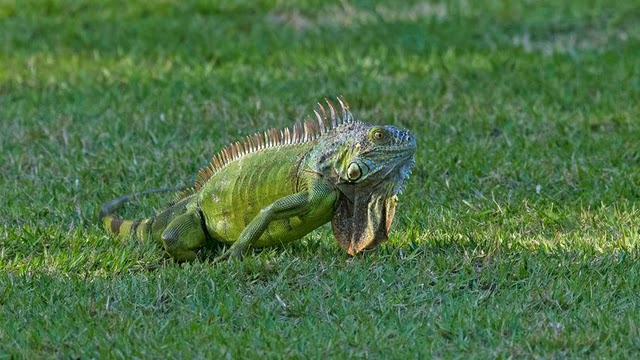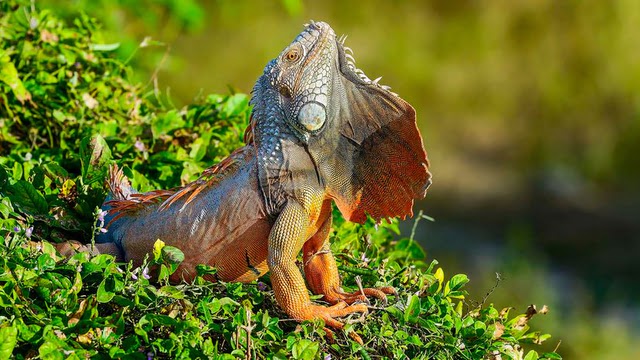Quck answer
Green iguanas have become a serious problem in South Florida due to their rapid reproduction and lack of natural predators. The invasive species causes damage to infrastructure, gardens, and native plants. They are also carriers of salmonella, making them a health hazard. The Florida Fish and Wildlife Conservation Commission encourages residents to take measures to control their population, including humane trapping and removal, as well as discouraging feeding and providing shelter for the iguanas. The commission also warns against releasing captured iguanas into the wild, as this only exacerbates the problem.
Animal Facts

Green iguanas (Iguana iguana) have become an invasive species in South Florida, causing damage to properties and destroying native plants. The subtropical climate and lack of natural predators in the area have allowed the big lizards to thrive, but residents are not happy about it.
Florida is experiencing an unusual phenomenon where iguanas have taken over the state. Green iguanas, in particular, are flourishing in South Florida due to the climate and lack of predators. These large lizards are not native to the area and are causing destruction to properties and native wildlife.
The green iguana, also known as Iguana iguana, is one of the largest lizards in the Western Hemisphere. Females can grow up to 5 feet (1.5 meters) long, while males can reach up to 7 feet (2.1 meters) in length. They can weigh up to 17 pounds (7.7 kilograms) and are primarily herbivorous, eating fruits and leaves. Despite their size, green iguanas are popular in the exotic pet trade, which has allowed them to spread beyond their natural range.
What Are Green Iguanas?
Green iguanas are primarily herbivorous and feed on fruits and leaves. They are tree-loving animals and spend most of their time in forest canopies. They are excellent climbers, with long fingers and hooked claws, and can survive falls of up to 50 feet (15.2 meters) without injury. They are also comfortable in water and can swim using their tails to undulate from side to side.
Green iguanas are somewhat gregarious, with hatchlings forming social groups with their siblings for mutual protection. Meanwhile, male iguanas put on elaborate mating displays to attract females. They have dewlaps, which are folds of loose skin that dangle below the neck, and males have larger dewlaps than females. During breeding season, males defend a large territory and aggressively bob their heads up and down to scare off rivals. Green iguanas come in various colors, including green, brown, blue, red, and gray, and males often turn orange or bronze during mating season.

Despite its name, not all green iguanas have green skin.
Arto Hakola/Getty Images
The green iguana is a popular pet reptile in the United States. However, they require proper care and attention. Before deciding to keep one as a pet, it’s important to understand their needs.
An 8-inch hatchling can be kept in a tabletop terrarium, but as they grow, they need a larger enclosure. Experienced hobbyists suggest adult enclosures should be at least 6 feet high, 6 feet wide, and 12 feet long. Additionally, green iguanas have specific requirements for their diet, heating, lighting, humidity, and substrate. (More information can be found here.)
How Did Iguanas End Up in Florida?
Green iguanas were originally found only in Central and South America and some islands in the eastern Pacific and Caribbean. However, they can thrive in areas where they don’t belong if the climate is favorable. In 1995, at least 15 green iguanas suddenly appeared on Anguilla, a Caribbean island with no previous iguana population. Scientists believe they drifted on floating mats of uprooted vegetation that traveled out to sea during Hurricanes Luis and Marilyn. They likely traveled from Guadeloupe, 200 miles to the south.
Human assistance was needed to bring iguanas to the United States. The first report on invasive iguanas in South Florida was published in 1966. It’s believed that many iguanas arrived on boats or in shipping crates. In 1995 alone, over 1.14 million iguanas were imported to the United States. While captive-bred specimens are available, many wild-caught babies are still shipped to the U.S.
Dealing With the Iguana Invasion in South Florida
The number of free-ranging green iguanas in South Florida is unclear, but over 7,000 sightings have been recorded by the University of Georgia’s Early Detection & Distribution Mapping System since 1998, with most sightings occurring since 2012. Many of these lizards are likely descendants of escaped or unwanted pets.
The herbivorous iguanas are causing damage to important native plants, such as the Gray nickerbean, which is essential for the endangered Miami blue butterfly larvae. Various flowers are also at risk. Homeowners and landscapers are frustrated with iguanas eating their gardens and leaving feces on patios, boat decks, and other surfaces.
Iguanas are also causing infrastructure damage. One iguana caused a 10-minute power outage at a Key West electrical facility in 2018, while tunneling iguanas caused $1.8 million in damages to a local dam in West Palm Beach.
In 2019, the Florida Fish and Wildlife Conservation Commission (FWC) encouraged homeowners to humanely kill iguanas on their property whenever possible. It’s legal to hunt them without a license or permit on public lands. Some citizens have suggested Floridians should eat more iguana meat, which is a traditional entree in some parts of the Caribbean.
Iguanas are unable to survive in colder regions due to their cold-blooded nature. Even in southern Florida, they can be affected by chilly conditions. In January 2020, temperatures as low as 32 to 41 degrees Fahrenheit (0 to 5 degrees Celsius) immobilized the iguanas in Miami and other parts of southern Florida. The lizards go into paralysis when the temperature drops to around 44 degrees Fahrenheit (6.6 degrees Celsius), resulting in pictures of motionless iguanas scattered across Florida on Twitter.
Although a cold snap in 2010 killed off a significant portion of the iguana population, they have rebounded and even flourished due to warmer temperatures. However, the cold weather won’t solve the invasive species epidemic. While most adult iguanas can recover from temporary incapacitation, they can still bite, so it’s best to keep a safe distance.
Green iguanas have established footholds in Puerto Rico, Texas, and multiple Hawaiian Islands, making them an invasive species. They are not typically dangerous but can bite if threatened. Iguanas are a popular choice for reptilian pets in the US and are generally friendly but may bite if they feel in danger.
FAQ
1. What are green iguanas?
Green iguanas are large lizards that are native to Central and South America. They are commonly kept as pets and have been introduced to various parts of the world, including Florida.
2. Why are green iguanas in South Florida considered a problem?
Green iguanas are considered a problem in South Florida because they are an invasive species that can cause damage to homes, gardens, and infrastructure. They also compete with native species for food and habitat.
3. How did green iguanas get to South Florida?
Green iguanas were likely introduced to South Florida through the pet trade. Some may have escaped or been released into the wild, and they have since established populations in the region.
4. What do green iguanas eat?
Green iguanas are primarily herbivores and eat a variety of plants and fruits. In South Florida, they have been known to feed on ornamental plants, fruits, and vegetables in people’s gardens.
5. Are green iguanas dangerous?
Green iguanas are generally not considered dangerous to humans. However, they can scratch or bite if they feel threatened or cornered. They also carry Salmonella, which can cause illness in humans if ingested.
6. How can green iguanas be controlled?
Green iguanas can be controlled through a variety of methods, including trapping, shooting, and fencing. However, these methods can be controversial and may not be effective in the long term. Some experts recommend focusing on reducing the demand for green iguanas as pets and improving regulation of the pet trade.
7. What is being done to address the green iguana problem in South Florida?
Various government agencies and organizations are working to address the green iguana problem in South Florida. These efforts include monitoring populations, educating the public, and testing new control methods.
8. Can green iguanas be relocated?
Green iguanas can be relocated, but this is generally not recommended as it can be stressful for the animals and may not be effective in controlling populations. It is also illegal to transport green iguanas across state lines without a permit.
9. Are green iguanas protected by law?
Green iguanas are not protected by law in Florida and can be hunted year-round without a permit. However, they are protected under animal welfare laws, which prohibit cruelty and inhumane treatment.
10. What can individuals do to help address the green iguana problem in South Florida?
Individuals can help address the green iguana problem in South Florida by not keeping them as pets, reporting sightings to local authorities, and taking steps to deter them from their property, such as using fencing or planting less attractive vegetation.





Leave a Reply